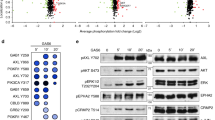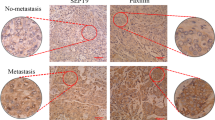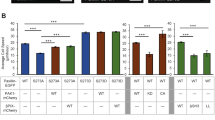Abstract
Vimentin is an intermediate filament protein whose expression correlates with increased metastatic disease, reduced patient survival and poor prognosis across multiple tumor types. Despite these well-characterized correlations, the molecular role of vimentin in cancer cell motility remains undefined. To approach this, we used an unbiased phosphoproteomics screen in lung cancer cell lines to discover cell motility proteins that show significant changes in phosphorylation upon vimentin depletion. We identified the guanine nucleotide exchange factor (GEF), VAV2, as having the greatest loss of phosphorylation owing to vimentin depletion. Since VAV2 serves as a GEF for the small Rho GTPase Rac1, a key player in cell motility and adhesion, we explored the vimentin-VAV2 pathway as a potential novel regulator of lung cancer cell motility. We show that VAV2 localizes to vimentin-positive focal adhesions (FAs) in lung cancer cells and complexes with vimentin and FA kinase (FAK). Vimentin loss impairs both pY142-VAV2 and downstream pY397-FAK activity showing that vimentin is critical for maintaining VAV2 and FAK activity. Importantly, vimentin depletion reduces the activity of the VAV2 target, Rac1, and a constitutively active Rac1 rescues defects in FAK and cell adhesion when vimentin or VAV2 is compromised. Based upon this data, we propose a model whereby vimentin promotes FAK stabilization through VAV2-mediated Rac1 activation. This model may explain why vimentin expressing metastatic lung cancer cells are more motile and invasive.
This is a preview of subscription content, access via your institution
Access options
Subscribe to this journal
Receive 50 print issues and online access
$259.00 per year
only $5.18 per issue
Buy this article
- Purchase on Springer Link
- Instant access to full article PDF
Prices may be subject to local taxes which are calculated during checkout








Similar content being viewed by others
References
Singh GK, Miller BA, Hankey BF . Changing area socioeconomic patterns in U.S. cancer mortality, 1950–1998: part II–Lung and colorectal cancers. J Natl Cancer Inst 2002; 94: 916–925.
Pisters KM, Le Chevalier T . Adjuvant chemotherapy in completely resected non-small-cell lung cancer. J Clin Oncol 2005; 23: 3270–3278.
Patz EF Jr, Swensen SJ, Herndon JE 2nd . Estimate of lung cancer mortality from low-dose spiral computed tomography screening trials: implications for current mass screening recommendations. J Clin Oncol 2004; 22: 2202–2206.
Herman JG, Baylin SB . Gene silencing in cancer in association with promoter hypermethylation. N Engl J Med 2003; 349: 2042–2054.
Baylin SB, Esteller M, Rountree MR, Bachman KE, Schuebel K, Herman JG . Aberrant patterns of DNA methylation, chromatin formation and gene expression in cancer. Hum Mol Genet 2001; 10: 687–692.
Greenburg G, Hay ED . Epithelia suspended in collagen gels can lose polarity and express characteristics of migrating mesenchymal cells. J Cell Biol 1982; 95: 333–339.
Stoker M, Perryman M . An epithelial scatter factor released by embryo fibroblasts. J Cell Sci 1985; 77: 209–223.
Thiery JP . Epithelial-mesenchymal transitions in tumour progression. Nat Rev Cancer 2002; 2: 442–454.
Liu LK, Jiang XY, Zhou XX, Wang DM, Song XL, Jiang HB . Upregulation of vimentin and aberrant expression of E-cadherin/beta-catenin complex in oral squamous cell carcinomas: correlation with the clinicopathological features and patient outcome. Mod Pathol 2010; 23: 213–224.
Hu L, Lau SH, Tzang CH, Wen JM, Wang W, Xie D et al. Association of Vimentin overexpression and hepatocellular carcinoma metastasis. Oncogene 2004; 23: 298–302.
Wei J, Xu G, Wu M, ang Y, Li Q, Liu P et al. Overexpression of vimentin contributes to prostate cancer invasion and metastasis via src regulation. Anticancer Res 2008; 28: 327–334.
Wang JW, Peng SY, Li JT, Wang Y, Zhang ZP, Cheng Y et al. Identification of metastasis-associated proteins involved in gallbladder carcinoma metastasis by proteomic analysis and functional exploration of chloride intracellular channel 1. Cancer Lett 2009; 281: 71–81.
Singh S, Sadacharan S, Su S, Belldegrun A, Persad S, Singh G . Overexpression of vimentin: role in the invasive phenotype in an androgen-independent model of prostate cancer. Cancer Res 2003; 63: 2306–2311.
Liu Z, Brattain MG, Appert H . Differential display of reticulocalbin in the highly invasive cell line, MDA-MB-435, versus the poorly invasive cell line, MCF-7. Biochem Biophys Res Commun 1997; 231: 283–289.
Chang L, Goldman RD . Intermediate filaments mediate cytoskeletal crosstalk. Nat Rev Mol Cell Biol 2004; 5: 601–613.
Zeisberg M, Neilson EG . Biomarkers for epithelial-mesenchymal transitions. J Clin Invest 2009; 119: 1429–1437.
Soltermann A, Tischler V, Arbogast S, Braun J, Probst-Hensch N, Weder W et al. Prognostic significance of epithelial-mesenchymal and mesenchymal-epithelial transition protein expression in non-small cell lung cancer. Clin Cancer Res 2008; 14: 7430–7437.
Al-Saad S, Al-Shibli K, Donnem T, Persson M, Bremnes RM, Busund LT . The prognostic impact of NF-kappaB p105, vimentin, E-cadherin and Par6 expression in epithelial and stromal compartment in non-small-cell lung cancer. Br J Cancer 2008; 99: 1476–1483.
Dauphin M, Barbe C, Lemaire S, Nawrocki-Raby B, Lagonotte E, Delepine G et al. Vimentin expression predicts the occurrence of metastases in non small cell lung carcinomas. Lung Cancer 2013; 81: 117–122.
Li QF, Spinelli AM, Wang R, Anfinogenova Y, Singer HA, Tang DD . Critical role of vimentin phosphorylation at Ser-56 by p21-activated kinase in vimentin cytoskeleton signaling. J Biol Chem 2006; 281: 34716–34724.
Mendez MG, Kojima S, Goldman RD . Vimentin induces changes in cell shape, motility, and adhesion during the epithelial to mesenchymal transition. FASEB J 2010; 24: 1838–1851.
Tsuruta D, Jones JC . The vimentin cytoskeleton regulates focal contact size and adhesion of endothelial cells subjected to shear stress. J Cell Sci 2003; 116: 4977–4984.
Kreis S, Schonfeld HJ, Melchior C, Steiner B, Kieffer N . The intermediate filament protein vimentin binds specifically to a recombinant integrin alpha2/beta1 cytoplasmic tail complex and co-localizes with native alpha2/beta1 in endothelial cell focal adhesions. Exp Cell Res 2005; 305: 110–121.
Bhattacharya R, Gonzalez AM, Debiase PJ, Trejo HE, Goldman RD, Flitney FW et al. Recruitment of vimentin to the cell surface by beta3 integrin and plectin mediates adhesion strength. J Cell Sci 2009; 122: 1390–1400.
White DE, Kurpios NA, Zuo D, Hassell JA, Blaess S, Mueller U et al. Targeted disruption of beta1-integrin in a transgenic mouse model of human breast cancer reveals an essential role in mammary tumor induction. Cancer Cell 2004; 6: 159–170.
Sieg DJ, Hauck CR, Ilic D, Klingbeil CK, Schaefer E, Damsky CH et al. FAK integrates growth-factor and integrin signals to promote cell migration. Nat Cell Biol 2000; 2: 249–256.
Zhu QS, Rosenblatt K, Huang KL, Lahat G, Brobey R, Bolshakov S et al. Vimentin is a novel AKT1 target mediating motility and invasion. Oncogene 2011; 30: 457–470.
Ivaska J, Vuoriluoto K, Huovinen T, Izawa I, Inagaki M, Parker PJ . PKCepsilon-mediated phosphorylation of vimentin controls integrin recycling and motility. EMBO J 2005; 24: 3834–3845.
Helfand BT, Mendez MG, Murthy SN, Shumaker DK, Grin B, Mahammad S et al. Vimentin organization modulates the formation of lamellipodia. Mol Biol Cell 2011; 22: 1274–1289.
Abe K, Rossman KL, Liu B, Ritola KD, Chiang D, Campbell SL et al. Vav2 is an activator of Cdc42, Rac1, and RhoA. J Biol Chem 2000; 275: 10141–10149.
Miller SL, Antico G, Raghunath PN, Tomaszewski JE, Clevenger CV . Nek3 kinase regulates prolactin-mediated cytoskeletal reorganization and motility of breast cancer cells. Oncogene 2007; 26: 4668–4678.
Lai SY, Ziober AF, Lee MN, Cohen NA, Falls EM, Ziober BL . Activated Vav2 modulates cellular invasion through Rac1 and Cdc42 in oral squamous cell carcinoma. Oral Oncol 2008; 44: 683–688.
Marignani PA, Carpenter CL . Vav2 is required for cell spreading. J Cell Biol 2001; 154: 177–186.
Tamas P, Solti Z, Bauer P, Illés A, Sipeki S, Bauer A et al. Mechanism of epidermal growth factor regulation of Vav2, a guanine nucleotide exchange factor for Rac. J Biol Chem 2003; 278: 5163–5171.
Ahn J, Truesdell P, Meens J, Kadish C, Yang X, Boag AH et al. Fer protein-tyrosine kinase promotes lung adenocarcinoma cell invasion and tumor metastasis. Mol Cancer Res 2013; 11: 952–963.
Bershadsky AD, Tint IS, Svitkina TM . Association of intermediate filaments with vinculin-containing adhesion plaques of fibroblasts. Cell Motil Cytoskeleton 1987; 8: 274–283.
Seifert GJ, Lawson D, Wiche G . Immunolocalization of the intermediate filament-associated protein plectin at focal contacts and actin stress fibers. Eur J Cell Biol 1992; 59: 138–147.
Gonzales M, Weksler B, Tsuruta D, Goldman RD, Yoon KJ, Hopkinson SB et al. Structure and function of a vimentin-associated matrix adhesion in endothelial cells. Mol Biol Cell 2001; 12: 85–100.
Burgstaller G, Gregor M, Winter L, Wiche G . Keeping the vimentin network under control: cell-matrix adhesion-associated plectin 1f affects cell shape and polarity of fibroblasts. Mol Biol Cell 2010; 21: 3362–3375.
Chan KT, Bennin DA, Huttenlocher A . Regulation of adhesion dynamics by calpain-mediated proteolysis of focal adhesion kinase (FAK). J Biol Chem 2010; 285: 11418–11426.
Lim JA, Hwang SH, Kim MJ, Kim SS, Kim HS . N-terminal cleavage fragment of focal adhesion kinase is required to activate the survival signalling pathway in cultured myoblasts under oxidative stress. FEBS J 2012; 279: 3573–3583.
Liu BP, Burridge K . Vav2 activates Rac1, Cdc42, and RhoA downstream from growth factor receptors but not beta1 integrins. Mol Cell Biol 2000; 20: 7160–7169.
Schuebel KE, Bustelo XR, Nielsen DA, Song BJ, Barbacid M, Goldman D et al. Isolation and characterization of murine vav2, a member of the vav family of proto-oncogenes. Oncogene 1996; 13: 363–371.
Schuebel KE, Movilla N, Rosa JL, Bustelo XR . Phosphorylation-dependent and constitutive activation of Rho proteins by wild-type and oncogenic Vav-2. EMBO J 1998; 17: 6608–6621.
Wittmann T, Bokoch GM, Waterman-Storer CM . Regulation of leading edge microtubule and actin dynamics downstream of Rac1. J Cell Biol 2003; 161: 845–851.
Rottner K, Hall A, Small JV . Interplay between Rac and Rho in the control of substrate contact dynamics. Curr Biol 1999; 9: 640–648.
Deakin NO, Ballestrem C, Turner CE . Paxillin and Hic-5 interaction with vinculin is differentially regulated by Rac1 and RhoA. PLoS ONE 2012; 7: e37990.
Carr HS, Morris CA, Menon S, Song EH, Frost JA . Rac1 controls the subcellular localization of the Rho guanine nucleotide exchange factor Net1A to regulate focal adhesion formation and cell spreading. Mol Cell Bio 2013; 33: 622–634.
Nobes CD, Hall A . Rho rac, and cdc42 GTPases regulate the assembly of multimolecular focal complexes associated with actin stress fibers, lamellipodia, and filopodia. Cell 1995; 81: 53–62.
Citterio C, Menacho-Marquez M, Garcia-Escudero R, Larive RM, Barreiro O, Sánchez-Madrid F et al. The rho exchange factors vav2 and vav3 control a lung metastasis-specific transcriptional program in breast cancer cells. Sci Signal 2012; 5: ra71.
Yamauchi J, Miyamoto Y, Tanoue A, Shooter EM, Chan JR . Ras activation of a Rac1 exchange factor, Tiam1, mediates neurotrophin-3-induced Schwann cell migration. Proc Natl Acad Sci USA 2005; 102: 14889–14894.
Chang F, Lemmon CA, Park D, Romer LH . FAK potentiates Rac1 activation and localization to matrix adhesion sites: a role for betaPIX. Mol Biol Cell 2007; 18: 253–264.
Charrasse S, Comunale F, Fortier M, Portales-Casamar E, Debant A, Gauthier-Rouviere C . M-cadherin activates Rac1 GTPase through the Rho-GEF trio during myoblast fusion. Mol Biol Cell 2007; 18: 1734–1743.
Garrett TA, Van Buul JD, Burridge K . VEGF-induced Rac1 activation in endothelial cells is regulated by the guanine nucleotide exchange factor Vav2. Exp Cell Res 2007; 313: 3285–3297.
Kallergi G, Agelaki S, Markomanolaki H, Georgoulias V, Stournaras C . Activation of FAK/PI3K/Rac1 signaling controls actin reorganization and inhibits cell motility in human cancer cells. Cell Physiol Biochem 2007; 20: 977–986.
Choma DP, Milano V, Pumiglia KM, DiPersio CM . Integrin alpha3beta1-dependent activation of FAK/Src regulates Rac1-mediated keratinocyte polarization on laminin-5. J Invest Dermatol 2007; 127: 31–40.
Acknowledgements
This work was supported by the National Cancer Institute (1R01CA1428580) awarded to AIM and through a Ruth L Kirschstein National Research Service Award (1F32CA168112-01) awarded to LSH Research reported in this publication was supported in part by the Winship and Emory Integrated Cellular Imaging Core and NIH/NCI under award number P30CA138292. The content is solely the responsibility of the authors and does not necessarily represent the official views of the National Institutes of Health. We would like to thank the Custom Cloning Core at Emory University for generating the mutant FAK constructs and Doris Powell in the laboratory of Paula Vertino for her technical assistance with the quantitative RT-PCR experiments. We would also like to thank Anthea Hammond for reviewing this manuscript. In addition, we thank Keith Burridge at the University of North Carolina for generously supplying us with the VAV2 plasmids.
Author information
Authors and Affiliations
Corresponding author
Ethics declarations
Competing interests
The authors declare no conflict of interest.
Additional information
Supplementary Information accompanies this paper on the Oncogene website
Supplementary information
Rights and permissions
About this article
Cite this article
Havel, L., Kline, E., Salgueiro, A. et al. Vimentin regulates lung cancer cell adhesion through a VAV2–Rac1 pathway to control focal adhesion kinase activity. Oncogene 34, 1979–1990 (2015). https://doi.org/10.1038/onc.2014.123
Received:
Revised:
Accepted:
Published:
Issue Date:
DOI: https://doi.org/10.1038/onc.2014.123
This article is cited by
-
FRMD3 inhibits the growth and metastasis of breast cancer through the ubiquitination-mediated degradation of vimentin and subsequent impairment of focal adhesion
Cell Death & Disease (2023)
-
MiR-22-3p suppresses NSCLC cell migration and EMT via targeting RAC1 expression
Functional & Integrative Genomics (2023)
-
LncIRF1 promotes chicken resistance to ALV-J infection
3 Biotech (2023)
-
Vav2 is a novel APP-interacting protein that regulates APP protein level
Scientific Reports (2022)
-
Evaluation of circulating small extracellular vesicle-derived miRNAs as diagnostic biomarkers for differentiating between different pathological types of early lung cancer
Scientific Reports (2022)



